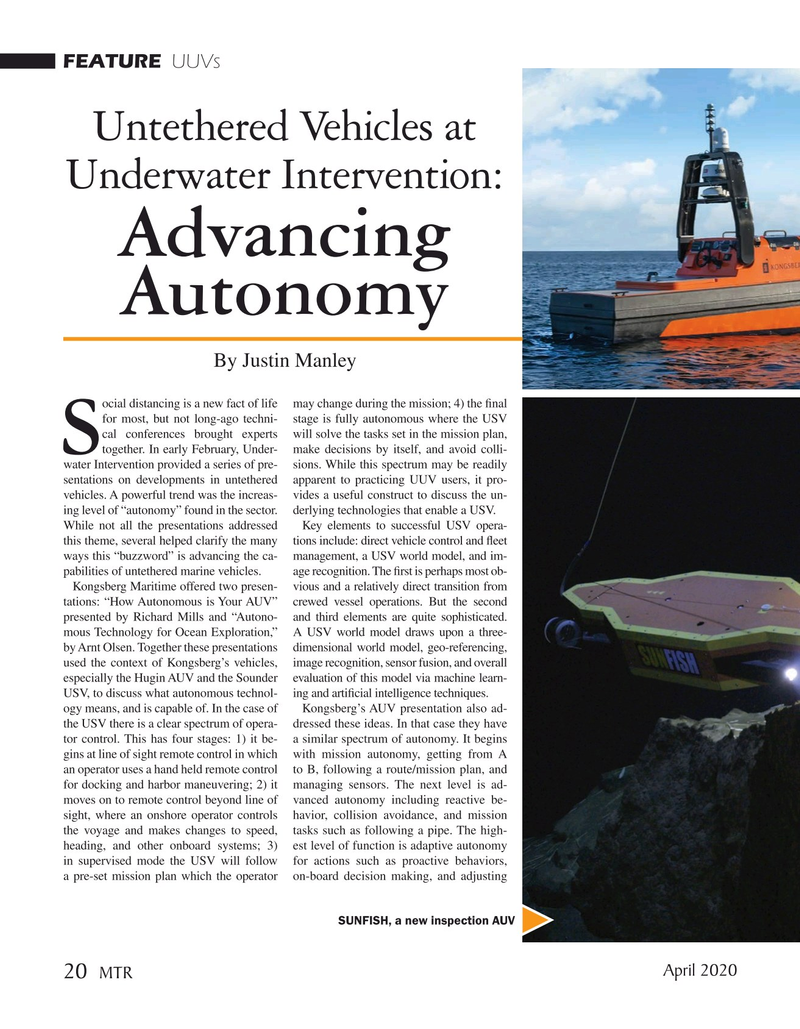
Page 20: of Marine Technology Magazine (April 2020)
Read this page in Pdf, Flash or Html5 edition of April 2020 Marine Technology Magazine
FEATURE UUVs
Untethered Vehicles at
Underwater Intervention:
Advancing
Autonomy
By Justin Manley ocial distancing is a new fact of life may change during the mission; 4) the fnal for most, but not long-ago techni- stage is fully autonomous where the USV cal conferences brought experts will solve the tasks set in the mission plan,
Stogether. In early February, Under- make decisions by itself, and avoid colli- water Intervention provided a series of pre- sions. While this spectrum may be readily sentations on developments in untethered apparent to practicing UUV users, it pro- vehicles. A powerful trend was the increas- vides a useful construct to discuss the un- ing level of “autonomy” found in the sector. derlying technologies that enable a USV.
While not all the presentations addressed Key elements to successful USV opera- this theme, several helped clarify the many tions include: direct vehicle control and feet ways this “buzzword” is advancing the ca- management, a USV world model, and im- pabilities of untethered marine vehicles. age recognition. The frst is perhaps most ob-
Kongsberg Maritime offered two presen- vious and a relatively direct transition from tations: “How Autonomous is Your AUV” crewed vessel operations. But the second presented by Richard Mills and “Autono- and third elements are quite sophisticated. mous Technology for Ocean Exploration,” A USV world model draws upon a three- by Arnt Olsen. Together these presentations dimensional world model, geo-referencing, used the context of Kongsberg’s vehicles, image recognition, sensor fusion, and overall especially the Hugin AUV and the Sounder evaluation of this model via machine learn-
USV, to discuss what autonomous technol- ing and artifcial intelligence techniques. ogy means, and is capable of. In the case of Kongsberg’s AUV presentation also ad- the USV there is a clear spectrum of opera- dressed these ideas. In that case they have tor control. This has four stages: 1) it be- a similar spectrum of autonomy. It begins gins at line of sight remote control in which with mission autonomy, getting from A an operator uses a hand held remote control to B, following a route/mission plan, and for docking and harbor maneuvering; 2) it managing sensors. The next level is ad- moves on to remote control beyond line of vanced autonomy including reactive be- sight, where an onshore operator controls havior, collision avoidance, and mission the voyage and makes changes to speed, tasks such as following a pipe. The high- heading, and other onboard systems; 3) est level of function is adaptive autonomy in supervised mode the USV will follow for actions such as proactive behaviors, a pre-set mission plan which the operator on-board decision making, and adjusting
SUNFISH, a new inspection AUV April 2020 20
MTR

 19
19

 21
21
